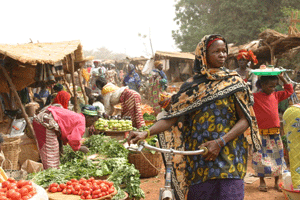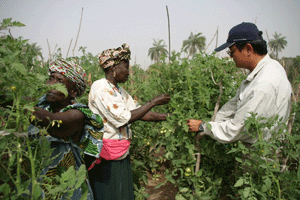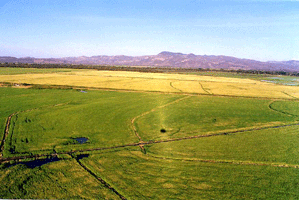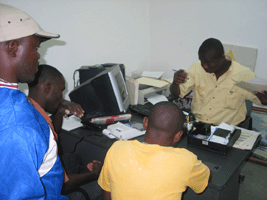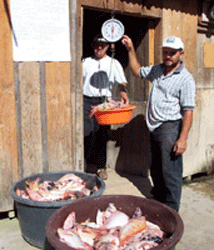|
 TaiwanICDF helping expand the frontiers of microfinance TaiwanICDF helping expand the frontiers of microfinance
|
By Leo R. Maliksi
|
|
▲Microfinance helps underprivileged people to start or expand businesses , increasing their incomes and improving their lives. |
When the Bangladeshi economist Muhammad Yunus, and the Grameen Bank he founded, won last year's Nobel Peace Prize, even those unfamiliar with the financial world gained an insight into microcredit - a small loan to a client made by a bank or other institution. Microcredit can be offered, often without collateral, to an individual or through group lending and is the most common microfinance product - a loan of usually less than US$100. This small-scale financing is often enough to assist hardworking microentrepreneurs with the establishment or expansion of small businesses such as basket-weaving, raising chickens, or buying wholesale products to sell at a market.
Yunus used Grameen Bank to provide loans that have enabled poor people around the world, especially women, to buy cows, a few chickens, or the cell phones they desperately need to help their small businesses earn money. Development economists have given the name "microenterprises" to these small businesses.
Microenterprises include self-employment activities and household enterprises, now considered essential for the sustainable social and economic development of developing and even developed countries. And in many countries, the self-employed, and household entrepreneurs, need financial services that are beyond a small loan. This is where microfinance comes in, with loans, savings, insurance, money transfer services, leasing and other financial products targeted at low-income clients.
Microfinance emerged in the 1970s as social innovators began to offer financial services to the working poor - those who were previously considered "un-bankable" because of their lack of collateral. Microfinance institutions (MFIs) not only learned that, given the opportunity, their clients expanded their businesses and increased their incomes, but they also observed high repayment rates, which demonstrated people's resolve and ability to transform their own lives.
A crucial tool
|
▲Women are often the major beneficiaries of microfinance projects. Gambian women have received capital and cultivation instruction from TaiwanICDF experts. |
In recent years, microfinance has emerged as an important tool for the TaiwanICDF in its efforts to help reduce poverty and support sustainable development. The TaiwanICDF engages in projects around the world that strengthen the environment for MFIs and microentrepreneurs. The aim of these projects is to enhance institutional capacity (education, training, and skills development) and ultimately provide direct support to MFIs, enabling them to expand their services and reach new clients.
Indonesia's Cooperative Rural Saving and Credit System (CRSCS) was the first beneficiary of the TaiwanICDF's microcredit lending projects. In 1995, the TaiwanICDF Board of Directors approved a US$10 million loan to the Bank of Indonesia, the country's central bank. That loan was channeled through the Indonesian Cooperative Bank (BUKOPIN) for re-lending to what are called primary cooperatives, the members of which are then able to access to financial assistance for their business activities, effectively helping villages accumulate capital.
In 1988, the TaiwanICDF funded a technical assistance project to a non-bank MFI, the Gambia Women's Finance Association (GAWFA), for capacity enhancement and financial sustainability. After evaluating the project, the TaiwanICDF noted that during implementation of its microcredit program, GAWFA might experience increased funding demand. The TaiwanICDF therefore decided to grant a loan channeled through the government of The Gambia to the Gambia Social Development Fund that then re-lent to qualified MFIs to finance local income-generating activities.
Small Farmholders' Financing Scheme
|
▲A birds-eye view of a paddy field at the Omar Torrijos Cooperative in Nicaragua. The TaiwanICDF funded this rice production project, providing farmers with much-needed equipment and financing. |
In 1998, the TaiwanICDF launched a two-tier model - a combination of agricultural skills training, and funding. Under this innovative model, a revolving fund was set up to assist farmers who participate in projects directed by overseas missions.
As well as working with local MFIs on microfinancing projects, and on small farmholders' financing schemes across Central America, the Caribbean, Asia, and Africa, the TaiwanICDF also cooperates with international development institutions to extend its operations through diverse international microfinancing networks, such as the ProCredit system, the Women's World Banking system, and the FINCA and other village banking systems.
Cooperation with the EBRD
|
▲Ryskul Ibraimova, of the Kyrgyz Republic, proudly displays her wares outside her store. The TaiwanICDF and EBRD's cooperation has helped her build a thriving business. |
In Central and Eastern Europe, the TaiwanICDF seeks to help enhance private sector development by cooperating with the European Bank for Reconstruction and Development (EBRD), through the Financial Intermediary Investment Special Fund (FIISF), which has been set up as a vehicle for various lending and investment ventures within Eastern Europe and Central Asia. This fund, administered by the EBRD, seeks to assist the development of market economies and micro-, small and medium sized enterprises (MSMEs) in these regions.
The FIISF has been utilized to support microfinance projects in Azerbaijan, Lithuania, Georgia, Ukraine and some Early Transition Countries (ETCs), such as the Kyrgyz Republic, Tajikistan, Azerbaijan, and Moldova. Cooperation with the EBRD helps the TaiwanICDF to expand the geographical scope of its operations.
Meanwhile, a second stage in this cooperative effort has seen the establishment of Small Business Accounts under the FIISF. One example is a loan to the Bank of Baku in Azerbaijan. The main objective of this and similar sub-projects is to provide micro and small enterprises (MSEs) with reliable access to bank finance. The loan enables the bank to expand its lending operations to MSEs, including those in rural and remote areas, which currently have little or no opportunity to access bank loans. The financing will help expand Bank of Baku's medium-term lending capacity to MSEs in a market where banks' and companies' access to longer-term financing is still limited.
Cooperation with the IDB
|
▲A member of staff with Micro-Credit National S.A., Haiti reviews applications from potential borrowers. |
The successful cooperation between the EBRD and the TaiwanICDF was a precursor to the establishment of another special fund: On March 27, 2006, the TaiwanICDF and the Multilateral Investment Fund (MIF), an entity under the Inter-American Development Bank (IDB), established the Specialized Financial Intermediary Development Fund. This fund, administered by the MIF, seeks to promote broad-based economic growth through microenterprises and small businesses in Latin America and the Caribbean. The TaiwanICDF contributed to this special fund and cooperates closely with the MIF, and its network, in the development of microfinance and in strengthening the business environment.
One MIF pilot project that is now being implemented seeks to create a housing finance market for individuals of Salvadoran
origin living in the U.S. The project involves launching transnational mortgage loans for the purchase of houses in El Salvador and seeks to channel remittances toward productive investments and housing.
The MIF assists Banco Agricola, the executing agency, in developing and testing new mortgage loans with a technical assistance component. Banco Agricola uses its large network of 23 remittance agencies and three bank branches to sell its mortgage loans, while the MIF's technical assistance includes developing a new software system, staff training, and marketing of the transnational mortgage loans. Using both technical assistance and funding, this pilot project seeks to test, and then demonstrate, the effectiveness of innovative financing services.
Through the MIF network, the TaiwanICDF assists qualified MFIs in Latin America and the Caribbean region, such as Banco Agricola and Fedecredito in El Salvador, Ficohsa in Honduras, Prodel and FINCA in Nicaragua, and Mutualista Pichincha in Ecuador.
|
▲The TaiwanICDF Small Farmholders' Financing Scheme provides group loans to fishermen's cooperatives near Lago de Yojoa, Honduras for the development of tilapia cage culture. |
Summary
By cooperating with reputable MFIs on developing and providing financial services, the TaiwanICDF is working together with those institutions to further develop the scope of microfinance. Microfinance is no longer just about providing loans to MSMEs, but also includes vital financial services and innovative financial products.
The above cases show how the TaiwanICDF seeks to achieve the objectives of its microfinance projects. Those objectives are to: (1) support diversified financial services by MFIs (2) strengthen partnerships with global MFI networks (3) enhance cooperation with international development institutions (4) develop complementary tools for technical cooperation with small-scale farmers (5) expand successful pilot programs.
Microfinance is now well-recognized as one of the most efficient ways to help facilitate self-employment, and thereby reduce poverty. Remaining fully committed to its mandate to help alleviate poverty and promote private sector development, the TaiwanICDF will continue to cooperate with international partners to expand its operations in the field of microfinance and other related areas in years to come.
- Update:
2022/05/11
- Hits:1072


